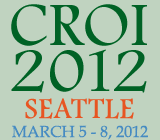 The first-ever head-to-head study of two one-pill, once-daily regimens—Gilead Sciences’ “Quad” tablet containing the experimental integrase inhibitor elvitegravir and boosting agent cobicistat along with tenofovir and emtricitabine, compared with Atripla (efavirenz plus emtricitabine and tenofovir)—shows comparable efficacy between the two, according to results presented Wednesday, March 7, at the 19th Conference on Retroviruses and Opportunistic Infections in Seattle.
The first-ever head-to-head study of two one-pill, once-daily regimens—Gilead Sciences’ “Quad” tablet containing the experimental integrase inhibitor elvitegravir and boosting agent cobicistat along with tenofovir and emtricitabine, compared with Atripla (efavirenz plus emtricitabine and tenofovir)—shows comparable efficacy between the two, according to results presented Wednesday, March 7, at the 19th Conference on Retroviruses and Opportunistic Infections in Seattle.
Gilead Study 102, a Phase III clinical trial expected to last nearly four years, randomized and treated 700 people living with HIV starting antiretroviral (ARV) therapy for the first time. Eighty-nine percent of the study volunteers were male, 37 percent were non-white, and 33 percent had pre-treatment viral loads in excess of 100,000 copies.
According to lead presenter Paul Sax, MD, of Brigham and Women’s Hospital in Boston, 88 percent of those who took the Quad tablet in the study had undetectable viral loads (less than 50 copies) after 48 weeks of treatment, compared with 84 percent of those who took Atripla. As these differences were within 12 percent of each other, the Quad regimen was concluded to be “non-inferior” to Atripla.
Virologic failure rates at week 48 were also similar: seven percent in both study groups.
Results were also similar among those who began therapy with high viral loads or low CD4 cell counts. Among those with pre-treatment viral loads above 100,000 copies, for example, 84 percent of those who received the Quad regimen, compared with 82 percent of those treated with Atripla, had undetectable viral loads at week 48.
CD4 increases were more substantial among those receiving Quad compared with Atripla: 239 versus 206 cells, respectively. This difference was statistically significant, meaning it was too great to have occurred by chance.
HIV drug resistance developed in a total of 16 study volunteers—eight people (2 percent) in the Quad group and eight (2 percent) in the Atripla group. Seven people in the Quad group developed HIV integrase inhibitor–associated resistance mutations, whereas eight patients in the Atripla group developed HIV non-nucleoside reverse transcriptase inhibitor–associated resistance mutations.
Mutations associated with resistance to tenofovir or emtricitabine occurred in eight patients in the Quad group, compared with two in the Atripla group.
As for common side effects—defined as those occurring in more than 10 percent of study volunteers—nausea occurred more frequently in the Quad group (21 percent) compared with the Atripla group (14 percent). Conversely, dizziness (7 percent vs. 24 percent), abnormal dreams (15 vs. 27 percent), insomnia (9 vs. 14 percent), and rash (6 vs. 12 percent) were more likely to be documented among those in the Atripla group.
Some differences in laboratory abnormalities were also documented. Compared with Atripla, the Quad was associated with a rapid increase in kidney function-related creatinine levels soon after therapy was started, remaining an average of 0.14 milligrams per deciliter (mg/dL) above pre-treatment levels through week 48. In the Atripla group, creatinine increases averaged 0.01 mg/dL over pre-treatment levels. Sax contended this will be an important laboratory outcome to watch for, particularly in clinical practice. He added that, according to statisticians working on the trial, only when creatinine levels increased by 0.4 mg/dL or more was there concern of renal toxicity.
Total, “bad” LDL and “good” HDL cholesterol levels were, on average, 9, 7 and 3 mg higher, respectively, in the Atripla group compared with those in the Quad group—all statistically significant differences. Triglyceride increases of 7 mg/dL were reported in both study groups.
The Phase III research program for Gilead’s Quad tablet includes two studies—Study 103, in addition to Study 102—evaluating the all-in-one regimen versus a standard of care among people starting HIV treatment for the first time. Sax concluded by noting that Gilead Study 103, also presented at CROI, demonstrated that the Quad tablet is non-inferior to Norvir (ritonavir)–boosted Reyataz (atazanavir) combined with Truvada (tenofovir plus emtricitabine).
He also reminded delegates in attendance that the Quad data has been submitted to regulatory agencies in Europe, Australia, Canada and Switzerland for approval consideration, with a decision from the U.S. Food and Drug Administrtion expected by August 27, 2012.
Advertisement
Advertisement
Advertisement






1 Comment
1 Comment